Gas stove dimensions
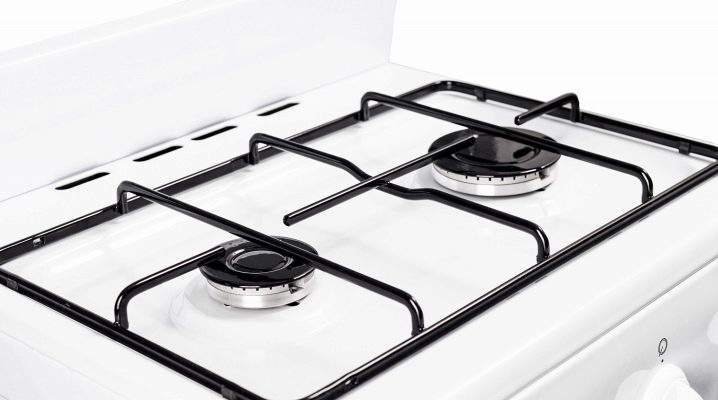
The question of the size of gas stoves is becoming especially relevant for owners of small kitchens. Indeed, how can a family place all kitchen utensils on 4 square meters in the same Khrushchev, when they need cabinets and shelves for dishes, kitchen towels and so on? So you often have to be guided when buying a gas stove not by your preferences in a particular company, but to pay first of all attention to the dimensions of the equipment.
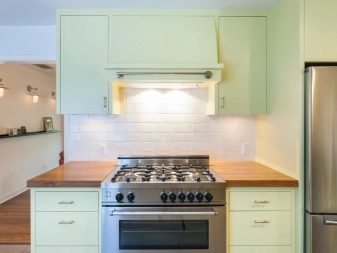


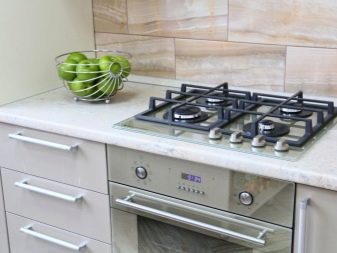
Peculiarities
The peculiarity of the dimensions of gas stoves is that, in general, they can be called the same type: the height is about 87 centimeters, the depth fluctuates around 52 cm, the standard width varies from 50 to 60 centimeters. The indicators noted are due to the standards associated with the layout of apartments and kitchens. The area of the dining room in multi-storey buildings had certain small standards. In this regard, wide gas stoves, as well as high ones, were simply not in demand. In fairness, it should be noted that the developers still provided models that allow, if necessary, to adjust the height of the slabs. The emphasis was on the adjustable feet, which also helped in cases with uneven floors.
Nowadays, thanks to the rapid construction of new residential buildings, where the kitchen area can be as large as 9 square meters, and 13 or even more, there is a demand for wider models of gas stoves. Thus, today their width can vary from 30 to 90 centimeters, depending on the number of burners. But the standard width is considered to be from 50 to 60 cm, assuming the presence of 4 burners. Some domestic manufacturers of gas stoves allow the manufacture of products according to individual customer sizes. True, such a pleasure will not be cheap.
The widest models are purchased mainly by large families, since several large pots can be placed on wide plates at the same time, which will shorten the cooking time. As for the depth of the product, it should in no way exceed the depth of kitchen cabinets, which is no more than 52 centimeters.

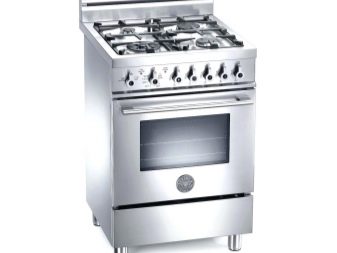
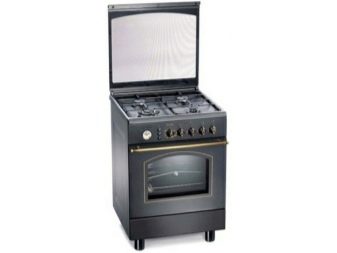
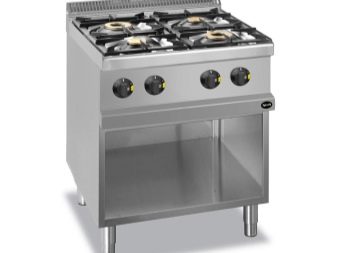
Standard sizes
Speaking about the standard sizes of gas stoves, it should be noted that the additional equipment directly depends on the dimensions. For example, the larger the dimensions, the more additional equipment is available (we are talking about a grill, a spit and other modern devices). Touching on the topic of dimensions, we are now talking only about the depth and width of the hob.
The height, as noted above, cannot exceed the permissible height of the kitchen furniture. Thus, this indicator is not taken into account when it comes to equipment.
Height
So, the height of a typical gas and electric stove does not exceed 82 centimeters (the reasons for this are noted above). Since this indicator does not affect anything (operation and equipment), then the question of making higher plates does not arise. In case of special need the adjustable feet mentioned above allow you to adjust the height up to +/- 5 centimeters.


Depth
Since recently, preference has been given to custom-made furniture, when buying a stove, it is necessary to take into account the depth indicator of the purchased device with the depth of the kitchen set, more precisely, with the countertop, near which the stove will be located.This is especially necessary to pay attention to the owners of small kitchens, who decided to save space by making bedside tables with a narrow table top. In this case the standard is from 50 to 60 cm.

Width
As for the width, taking into account the depth, it has several functionally significant variations. The narrowest are considered to be 30-centimeter two-burner stoves, which, for obvious reasons, are most likely designed for single people or young families. When you need something more practical, but compact (since narrow models are not designed for large dishes), it is recommended to pay attention to slabs 50x50 cmbecause they have a practical hob and a fairly spacious oven. Well, the overall dimensions, taking into account the adjustable legs of 50x50x85 cm, will allow you to easily fit the mentioned model into any interior.
If you need a good stove with an oven for a large family, then we recommend paying attention to the models, having dimensions of 50x60 cm.Rarely, you can find slabs 60x60 cm. And models with a hob width of 80 centimeters are considered exclusive. The permissible width of custom-made models can be up to 100 centimeters. In short, the width of narrow slabs ranges from 30 to 45 centimeters, and the standard ones include models with a width from 50 (less often 54 cm) to 60 cm.
When buying gas stoves, many justifiably pay special attention to the presence of a cast-iron grate. The fact is that having once bought a narrow plate with a grate made of enamel or stainless steel, over time you can notice that it has been deformed from constant incandescence, combined with the effect of gravity (it is allowed to make gratings only from cast iron, steel, stainless steel).
And the standard models, usually endowed with a cast iron grate, will last for many years, since cast iron is a durable material that is resistant to high temperatures.


Dimensions of built-in models
Recently, built-in gas stoves have been in great demand, allowing rational use of every centimeter of the kitchen area. The advantage of these models is that they can be easily built into any required surface. If desired, the oven can even be built into a wall cabinet, which, with the right approach, will save space.
The peculiarity of these models is that with a noticeable compactness, they have a fairly convenient hob, where 4 burners are located, designed for rather large dishes. The standard width of these models is 50-60 centimeters. The depth can be 45-55 cm, and the height is from 3 to 10 cm. This variety is also not limited to standard indicators, but individual manufacturers also provide for custom-made production.
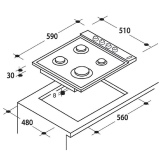



How to choose a hob?
Buyers who have planned the interior of the kitchen and have made a choice in favor of built-in stove models should pay attention to the hob, which can be made on a ceramic or metal base. Ceramics, of course, in this case is not pure glass, but a cermet alloy that can withstand loads just over 2 kilograms, which is not very convenient for large families.
Although unlike pure metal surfaces, ceramic evenly and quickly glow, retain heat longer. But, despite their quite pertinent advantages, they still have significant disadvantages. Firstly, such a surface, like any glass, is vulnerable to even minor impacts. Secondly, sudden changes in temperature (after a hot pot we immediately put a cold one) can cause cracks. Thirdly, repairs will cost several times more than repairing conventional plates.
The metal surface in operation does not differ from the metal surface of a conventional gas stove. Ease of use lies in the strength of the material that can withstand both sudden temperature changes and heavy dishes. In addition, the traditionally convex shape of the burners prevents liquid from spreading over the entire stove in cases where water "runs out" onto the hob.
As for the parameters, it is much easier to choose a model that fits perfectly into your interior. The options are narrow and wide. Narrow ones, as a rule, are represented by two or three burners. Their depth ranges from 40 to 45 cm, and their width ranges from 48 to 55 centimeters. But on store shelves you can find both 4, 5, and 6-burner series, the width of which can reach 90 centimeters, and the depth - 50 cm. However, the latter are rare models, in 2- and 4-burners are considered standard.




The selection of the hob must begin with determining the place in the headset where it will be built. Do not place it close to the sink, as your hands will be constantly burned while washing the dishes. The close proximity of the gas stove to the refrigerator is also undesirable, which will lead to the premature breakdown of the latter.
The recommended distance between them should be about 25 centimeters (usually it is filled with some kind of cabinet).
You can find out more about the sizes of gas stoves in the next video.













The comment was sent successfully.